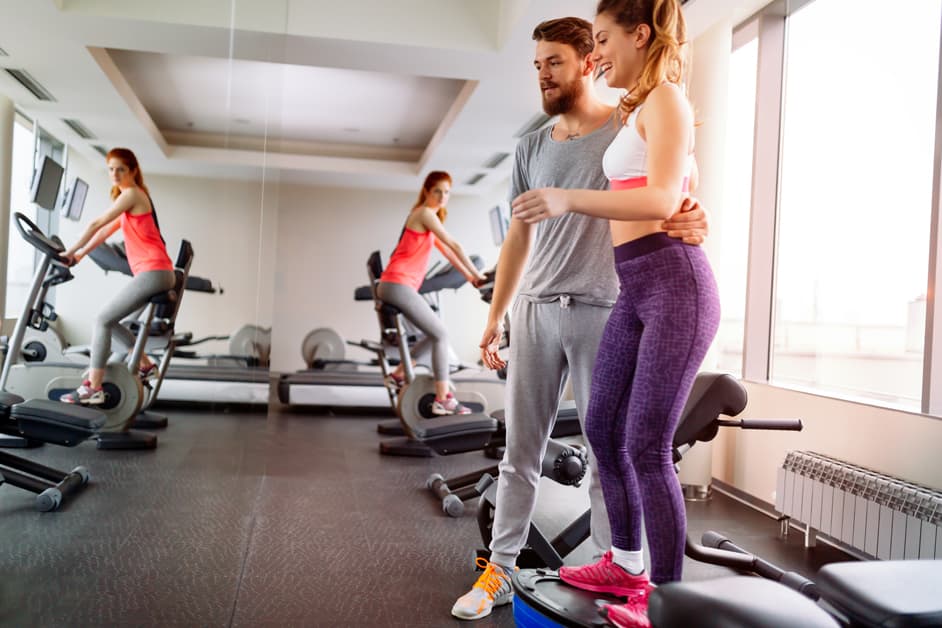Introduction
Balance training is a must for runners. Especially those with knee pain. Boosting your balance can reduce joint stress, lessen the risk of injury and even up your overall performance.
Here we look at why balance training is so important for knee pain sufferers. Plus, we provide a guide to the best balance exercises:
What is balance training?
Balance training is an exercise program to control the center of gravity and stabilise core muscles. It helps develop strength, agility, and posture control. It’s important for injury prevention and endurance.
For runners with knee pain, balance training strengthens and stabilises the hip muscles, reducing stress on the knee. It develops coordination and muscular agility. It’ll help dependent less on momentum when running.
Balance training helps common lower-extremity injuries like PFPS, shin splints, Achilles tendinopathy, IT Band Syndrome, and runner’s knee. It can be used prehabilitatively to reduce chances of injury or reinjury.
Benefits of balance training
Balance training can offer significant advantages to runners with knee pain. Evidence suggests it can enhance muscle strength and coordination, reduce falls, and even prevent injuries. Single-leg standing, closed-chain exercises, and plank variations are activities which can help improve balance for these runners.
- Single-leg standing can boost control of the knee joint muscles. It strengthens muscles, provides sensory stimulation, and improves endurance and ankle strength. This can reduce translation at the knee joint during running.
- Closed-chain exercises involve movement at the hip and knee joints, as well as stabilization from other muscles, like core muscles. Examples include squats/lunges, split squats/step ups and lunge variations with side steps and rotations.
- Plank variations are key for runners with knee pain. They aid core stability, which is needed for proper running mechanics. Planks are effective because they require different body segment stabilizations in one movement pattern. Strengthening the core helps tackle imbalances between trunk flexors and extensors, so lower limb joints don’t take on incorrect loading patterns during running or normal activities.
Knee Pain in Runners
Knee pain is a popular issue amongst runners. Balance training can be key in helping them to recover. Let’s learn why knee pain occurs in runners and how balance training can reduce it. This will bring relief and stop long-term damage.
Common causes of knee pain
Knee pain is a common issue for runners. To treat it, you must spot the cause. Typical culprits are patellofemoral pain syndrome (PFPS), iliotibial band (ITB) syndrome, meniscus tears, chondromalacia patella, tendonitis, and ligament damage.
PFPS happens when the kneecap does not move correctly in the groove at the top of the thighbone. This leads to inflammation, soreness, and deterioration of the kneecap cartilage. This may cause ache while running or climbing stairs.
ITB syndrome occurs when there is tightness or overuse on either side of the knee joint. This can lead to pain. Other problems like meniscus tears, chondromalacia patella, tendonitis, or ligament damage can also cause knee pain for runners.
You can reduce your risk of injury and ease existing symptoms with strength and balance exercises for muscles around the knees: quads, hamstrings, and calves. Improving ankle stability can also help.
Risk factors for knee pain
Runners often experience knee pain, and there are several risk factors to consider. Overpronation, weak muscles around the knee, imbalances in strength or flexibility between the quads and hamstrings, age, and injury can all increase the risk.
To reduce the risk of knee pain, runners should address any underlying issues that could be causing the pain. Balance training and supportive shoes can help, as well as proper hydration and warm-ups before each run. This can help prevent injury and further exacerbate existing conditions associated with running-related knee pain.
Balance Training for Runners with Knee Pain
Runners with knee pain? Balance training can help! It focuses on better control and coordination. This helps cut down injury risk. Balance training exercises can help runners with stability in the knee joint. Also, it increases range of motion and makes them run more smoothly.
In this article, we’ll see why balance training is great for runners with knee issues. Plus, we’ll look at the most effective exercises they can do.
Types of balance exercises
Balance is essential in all physical activities, including running. Poor balance can reduce performance and increase risk of injury. It’s especially important for those with knee pain, as it can contribute to it. To improve knee pain, a few balance exercises can help.
Examples of balance exercises include:
- One-legged standing
- Squats
- Planks on an unstable surface
- Single-leg stairs hops
- Single-leg squats
- Lunge jumps
- Closed chain exercises like one leg squat jumps and lateral hops
One leg stands improve coordination and core strength for complex trail running scenarios or faster tempo runs. Squats develop form, coordination, and strength in major lower body muscle groups like hips, quads, glutes and calves.
Closed chain exercises like squat jumps involve movement in multiple directions, strengthening muscles that control hip movements. Lateral hops need explosive power while engaging primary stabilizer muscles around the knees. This strengthens key stabilizing functions and core muscles.
How to incorporate balance training into your running program
Balance training is key for runners with knee pain. It can improve proprioception, the ability to sense and perceive body position and movement. Plus, reduce the risk of injuries in other muscles and joints while running.
Before starting, evaluate your strength, mobility and balance. A physical therapist or certified running coach can correct any imbalance.
Easy exercises to add to your routine:
- Single-leg Stance: Stand on one foot. Shift weight forward, back, side-to-side without letting the other foot touch the ground.
- Balance Board Training: Use a wobble board or Bosu ball for balance on different surfaces. Progress by doing heel raises and side lunges.
- Plyometric Exercises: Jump onto boxes/stairs or drop jump from raised surfaces.
Do each exercise with perfect form every time. Strengthen muscles for better posture and improved balance over time.
Conclusion
To wrap up, balance training is a key piece of the puzzle for runners who have knee pain. Adding it to an existing workout plan can lead to better knee stability and decreased odds of getting hurt in the future. Balance training is useful for improving performance too; it boosts balance in general and better coordination in the lower body.
Proprioceptive exercises such as wobble boards, Swiss balls and bosu balls are especially successful for improving balance around the knee.
Summary of benefits of balance training
Balance training can bring runners many advantages, especially those with knee pain. Coordination between muscles and proprioception are improved, working to take load off the joint. It helps efficiency when running, preventing falls or missteps that may cause more knee strain. Further, weak muscles around the knee can be strengthened, leading to an overall better balance when running, and less asymmetrical loading on the body. Another benefit is that runners can recognize potential muscular causes themselves, without having to ask for help.
In a nutshell, balance training gives control of movement and can identify posture and movement imbalances. This leads to better biomechanics when running which stops the knee from deteriorating and lowers discomfort.
- Improves coordination between muscles and proprioception
- Helps efficiency when running and prevents falls
- Strengthens weak muscles around the knee
- Gives runners control of movement
- Identifies posture and movement imbalances
- Leads to better biomechanics when running
- Stops the knee from deteriorating and lowers discomfort
Future research on balance training for runners with knee pain
This inquiry has revealed that balance training works for runners with knee soreness. Yet, more studies are necessary to understand the long-term effects, and whether it is successful for certain groups, like female runners or elderly people. Research should also examine if supervised and unsupervised training have different levels of success in reducing symptoms. Additionally, research can help select more appropriate balance exercises by looking at factors such as intensity, duration, and frequency.
Lastly, more experiments should explore how balance exercises reduce knee pain, so they can be tailored to a person’s needs. Well-designed randomized controlled trials will help gain insight into the effectiveness of balance training for runners with knee discomfort.
Frequently Asked Questions
Q1: What is balance training?
A1: Balance training is an exercise regimen that focuses on improving coordination and stability. It helps to strengthen the muscles and joints, which can help prevent injuries, and can also improve posture and agility.
Q2: How can balance training help with knee pain?
A2: Balance training can help with knee pain by strengthening the muscles and joints around the knee, which can help to reduce the strain on the knee joint. It can also help to improve coordination and stability, which can help to reduce the risk of falls or other injuries that could cause additional strain on the knee.
Q3: What exercises should I do for balance training?
A3: Exercises for balance training can include standing on one leg, walking heel-to-toe, and side-to-side stepping. Other exercises may include balance boards, bosu balls, and agility ladders.





